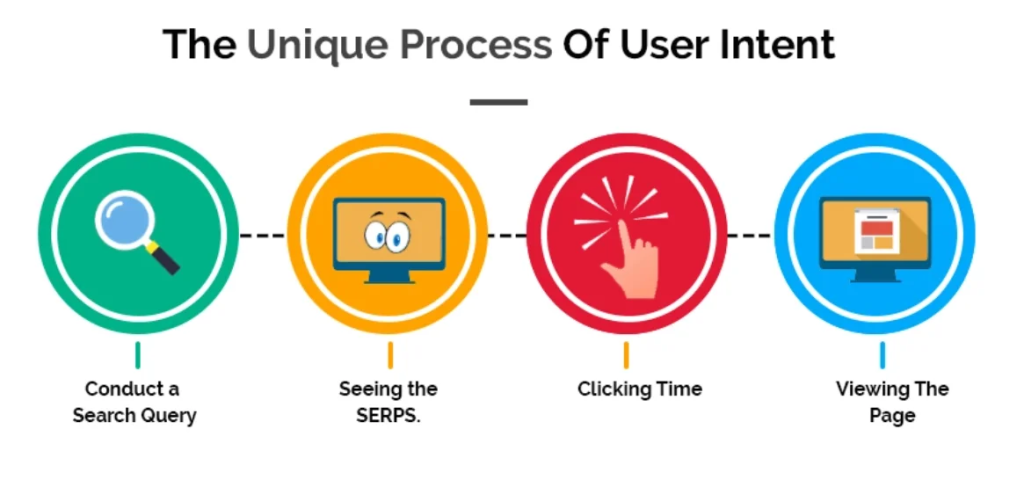
Hi Everyone!
This is Ravi and today, I will let you know about the Role of User Intent in SEO.
Definition
User intent, also referred to as search intent, is the underlying purpose behind a user’s search query. Grasping user intent is vital in search engine optimization (SEO) because it allows marketers to develop content that fulfills the needs and expectations of their audience, leading to better engagement, improved rankings, and higher conversion rates.
What Is Search Intent?

Search intent is the reason behind a user’s search query. It reveals what the user aims to achieve when they type a specific term into a search engine. By understanding search intent, marketers can create content that directly addresses the user’s needs, thereby improving search engine rankings and enhancing user experience.
Why Is Search Intent Important in SEO?

Improved Content Relevance
Aligning your content with user intent ensures it is relevant to the user’s search query, which can increase engagement and reduce bounce rates.
Higher Search Engine Rankings
Search engines, like Google, prioritize content that best satisfies user intent. By optimizing for user intent, you can improve your chances of ranking higher in search results.
Enhanced User Experience
Content that meets user intent provides a better user experience, leading to higher satisfaction and an increased likelihood of returning visitors.
Increased Conversions
Understanding and addressing user intent can lead to higher conversion rates, as users are more likely to take desired actions when their needs are met.
What Are the Different Types of User Intent?

Informational Intent
Users are seeking information or answers to specific questions.
Examples: “How to bake bread,” “What is quantum computing?”
Navigational Intent
Users are looking for a specific website or page.
Examples: “Twitter login,” “Netflix homepage.”
Transactional Intent
Users are ready to make a purchase or perform a specific online activity.
Examples: “Buy MacBook Air,” “Subscribe to Spotify.”
Commercial Investigation Intent
Users are researching products or services before making a purchase decision.
Examples: “Best DSLR cameras 2024,” “Bluehost vs. SiteGround.”
Why is User Intent So Important?

Understanding User Behavior
By understanding what users are looking for, you can better predict and meet their needs, leading to higher satisfaction and loyalty.
Creating Targeted Content
Content tailored to specific user intents is more likely to engage users and meet their needs, increasing the effectiveness of your SEO efforts.
Optimizing Marketing Strategies
Knowing user intent allows you to align your marketing strategies with the actual needs and behaviors of your target audience, improving overall campaign effectiveness.
Staying Competitive
As search engines continue to prioritize user-centric content, understanding user intent helps you stay competitive and adapt to changes in search algorithms.
How to Determine Search Intent
Conduct Keyword Research
Identify the keywords and phrases that your target audience is using. Tools like Google Keyword Planner, Ahrefs, and SEMrush can help.
Analyze Search Results
Examine the top-ranking pages for your target keywords to understand the type of content that Google considers relevant for those queries.
Study User Queries
Look at the questions and phrases users type into search engines related to your topic. Tools like AnswerThePublic and Google Search Console can provide valuable insights.
Use Analytics Tools
Tools like Google Analytics can provide data on user behavior, helping you understand what users are looking for when they visit your site.
Observe Competitor Content
Analyze how your competitors are addressing user intent in their content. This can provide ideas and benchmarks for your own content strategy.
FAQs
Q1: How can I optimize my content for user intent?
Conduct thorough keyword research, create content that directly addresses user queries, and regularly update and optimize your content based on performance data and changes in user behavior.
Q2: What tools can help me understand user intent?
Google Analytics, Google Search Console, AnswerThePublic, and BuzzSumo are useful tools for gaining insights into user intent and behavior.
Q3: How often should I update my content to align with user intent?
Regularly review and update your content to ensure it remains relevant and aligned with current user intents. This could be quarterly or bi-annually, depending on the industry and changes in user behavior.
Q4: What is the difference between informational and transactional intent?
Informational intent is when users seek information or answers to questions, while transactional intent is when users are ready to make a purchase or perform a specific online activity.
Understanding and optimizing for user intent is a vital aspect of successful SEO strategies. By focusing on the needs and motivations of your audience, you can create content that not only ranks well in search engines but also provides value to your users, leading to higher engagement, satisfaction, and conversions.
Thanks!